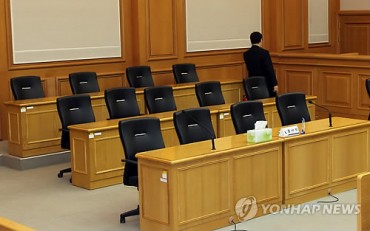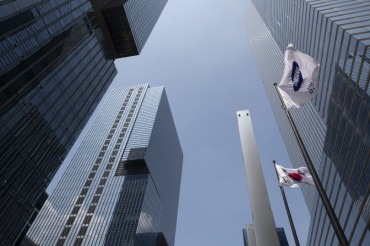
Despite the favorable conditions for office building market, the vacancy ratio in office buildings has increased much to the dismay of the landlords. (image: Gangnam Nights by Hannah Dae Perez/flickr)
SEOUL, Korea, April 19, 2014 (Korea Bizwire) – Office buildings are becoming more and more hollowed out. In the premium-grade skyscrapers in Seoul, it is rather easy to find empty offices these days. The vacancy rate in buildings in the Yoido district – Seoul’s main business and investment banking area dubbed as “Wall Street of Korea” – has exceeded 9 percent and the area is slowly turning from the pivot of financial dealings to almost a ghost town.
According to Genstar, a real estate agency for office buildings, the average vacancy rate in buildings in Seoul is estimated to be above 7 percent in the first quarter of 2014, a drastic increase from 4.9 percent last year.
Another agency reported that the vacancy rate in the whole city has reached 8.3 percent, which has doubled in four years, and the rental yields are dwindling away. In actuality, the city’s total number of office work categories has risen 4.5% over the previous year; For the past ten years, the average growth rate for the white collar jobs in Seoul stood at 2.6%. Despite the favorable conditions for office building market, the vacancy ratio in office buildings has increased much to the dismay of the landlords.
One of the main reasons for such stagnancy of the build leasing business is decreased demands for offices due to the delay in economic recovery. Corporate restructurings involving cutting down the number of offices are taking place in banks and other industrial sectors. An excessive supply of offices is another contributing factor. Five more office buildings (175,206 square meters in total) have newly come into the market in the first quarter only.
Cushman and Wakefield Korea, Korean operation of an American asset management company, reported that the vacancy rate in A-grade office buildings in the Gangnam district (total floor area greater than 30,000 square meters) was 8.0 percent, a 0.9 percentage point increase from 7.1 percent in the fourth quarter last year. It is not that different from the vacancy rate at the heart of Gangbuk area (9.6%) in which a series of new buildings recently has become available.
The upswing is much more pronounced in Gangnam. The rents in the old downtown area in Gangbuk are 15 to 30 percent more expensive than in Gangnam. However, the actual rents go down by 8 percent if the landlords in Gangbuk offer rent-free deals for one month. The gaps in rents can be overcome with rent exemptions for two to three months.
The headquarters of Microsoft Korea has moved out of the POSCO Building Daechi-dong in Gangnam area to K Twin Tower in Gwanghwamun in Gangbuk. Three out of five floors which used to be occupied by Microsoft Korea are still empty.
The old NC Soft building in Samsung-dong has come to be only 40 percent occupied since the game publisher moved to Pangyo in Gyeonggi Province. There are vacancies in Hibrand building in Yangjae-dong (Gangnam) as well, from which Motorola has moved out in December 2013.
Game and IT enterprises have left Gangnam long ago to fancy new buildings in Pangyo Techno Valley. Foreign companies, insurance, consulting and financial services companies are either reducing their office spaces or merged their branches due to the business downturn.
A real estate agency official said, “In order to invite anchor tenants, one month rent-free deals have been offered frequently, but now many landlords tend to offer 1.5 to 2 months rent-free these days, which means one gets to save rents for up to ten months with a five-year contract.”
The situations are even worse in smaller buildings on the side streets in Gangnam. According to a real estate agent, “subletting” which used to be practiced to invite retailers is cutting across the office buildings in Gangnam. Reportedly, some owners of old commercial buildings even commented that they are going through a tougher time than back in the 1997-98 financial crisis.
After the decision for Korea Electric Power Corporation to relocate to Naju in South Jeolla Province, scheduled in November, the vacancy rate near Samsung Subway Station would get far worse than it already has been since six KEPCO subsidiaries and Korea Hydro and Nuclear Power Company would also leave the area one by one. Seven out of 15 floors of Samsung I-Park Tower currently occupied by KHNP would also be back in the market.
Written by Robin Koo (linguistkoo@koreabizwire.com)
Lifestyle (Follow us @Lifestylenews_Korea)
Corrections: Information regarding the rising rate for white-collar jobs in the city of Seoul has proved misleading in the previous reporting, in which the writer said “Despite the fact that the city’s total number of office work categories has become twice of the past average, to account for 4.5 percent, the vacancy ratio in office buildings has increased much to the dismay of the landlords.”
After fact-checking process, we has corrected the part as follows: ” In actuality, the city’s total number of office work categories has risen 4.5% over the previous year; For the past ten years, the average growth rate for the white collar jobs in Seoul stood at 2.6%.” Despite the favorable conditions for office building market, the vacancy ratio in office buildings has increased much to the dismay of the landlords.”
We apologize for the inconvenience caused by the misleading information on the previous reporting. We will make sure every bit of information on our news coverage will agree with the fact. Thanks for reading.






